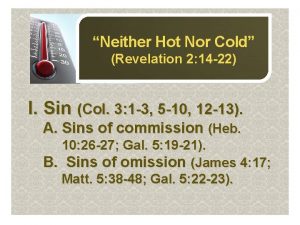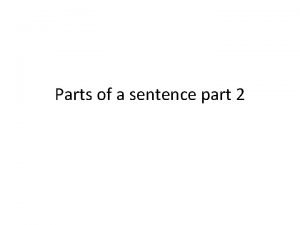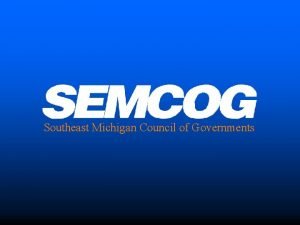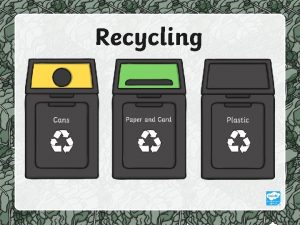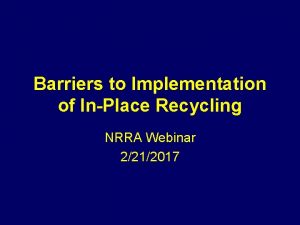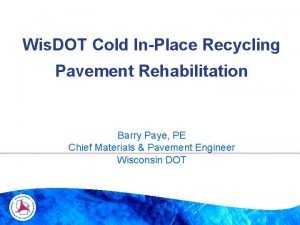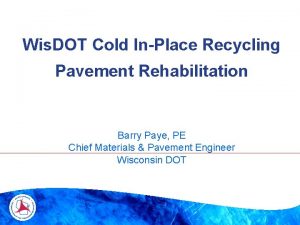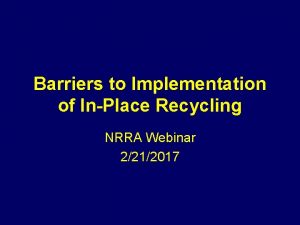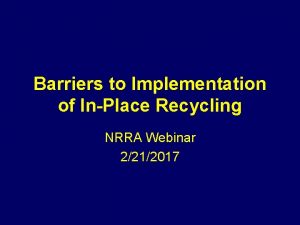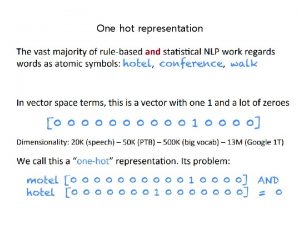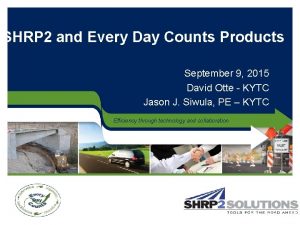Hot InPlace Recycling Every Day Counts 4 How


















































- Slides: 50

Hot In-Place Recycling Every Day Counts 4 - How Pavement Preservation Workshop September 10 -11, 2018 Portland, Oregon Stephen A. Cross, Ph. D, PE ARRA Technical Director Professor, Oklahoma State University

Asphalt Recycling & Reclaiming Association www. ARRA. org Industry Segments Cold Planing Hot In-place Recycling Cold Central Plant Recycling Full Depth Reclamation Soil Stabilization

Hot In-Place Recycling ► A pavement preservation and corrective maintenance technique ► When combined with asphalt overlay can be classified as structural rehabilitation ► Successfully used on all functional classes of roadways ► Economical (cost savings of up to 30 to 50% ► Sustainable, reduces carbon dioxide (CO 2) emissions, trucking, raw materials

Hot In-Place Recycling (HIR) Distressed Pavement = New Pavement Using A Train of Equipment that: n Heats RAP and existing binder n Scarifies deteriorated pavement n Mixes with rejuvenating agent n May add aggregate or new HMA n Re-paves recycled mix n Compacts to specified density

Three Methods HIR Surface Recycling 2. Remixing 3. Repaving ► Multiple configurations exist within each type. Key is to focus on the function, not the configuration of the equipment ► Typical depth: 0. 6 to 2. 0 inches ► Immediate opening to traffic ► Applicable for all traffic levels 1.

HIR – Surface Recycling ► Heating existing pavement ► Scarifying top 0. 75 to 2 inches of existing pavement ► Adding a rejuvenating agent ► Mixing the materials ► Placing and compacting recycled mixture ► Placing surface course

Surface Recycling

HIR - Remixing ► Heating existing pavement ► Scarifying top 0. 75 to 2 inches of existing pavement ► Adding a rejuvenating agent ► Adding additive, if desired, up to 30% n Admixture n New aggregate ► Mixing the materials in a mixing drum or pugmill ► Placing and compacting recycled mixture ► Placing surface course if desired

Surface Remixing

HIR - Repaving ► Heating existing pavement ► Scarifying top 0. 75 to 2 inches of existing pavement ► Adding a rejuvenating agent ► Mixing the materials ► Placing and compacting (simultaneously) an integral asphalt overlay ( 0. 5 to 3 inches thick) on the hot (>200 o. F) recycle layer

Repaving Screeds

Single & Multi-Stage HIR ► All HIR processes can use single or multi-stage recycling ► Single stage removes the entire treatment depth in one pass ► Multi-stage uses a series of preheater and heater/scarification units to sequentially heat and loosen the pavement in layers ► Remove in 1/2, 3/4 or 1 inch increments

MARS Multi-Stage HIR Pavement sequentially heated and loosened in ½ 3/4 “ increments with a series of pre-heater and heater scarification units ► Allows deeper treatment depths 1. 5 to 3 inches ► Allows more uniform heating ►

MARS Multi-Stage HIR ► ► The material is windrowed to expose the next lift of material for heating. Special Tunnel heaters are used to allow the windrow to enter the heaters ovens. There the underlying asphalt is heated and the windrow is kept at temperature.

Multi-Stage Remixing HIR ► First unit heats & mills pavement to desired depth (3/4 – 1 inch). ► Mixture is windrowed so it can pass over second unit.

Multi-Stage Remixing HIR ► Second unit heats & mills pavement to desired depth (3/4 – 1 inch). ► Add mix (new mix or aggregate) is added and all material mixed in pugmill.

HIR Compaction HIR mixtures compact similar to plant mix asphalt mixtures ► Pneumatic and/or double drum vibratory rollers are used ► Due to heating of the underlying pavement: ► n longer rolling times are available n a thermal bond forms between the existing pavement and HIR mixture

HIR Recycling—Benefits ► Eliminates surface irregularities ► Eliminates cracks ► Restores uniform grade line and cross- section ► Improves smoothness ► High production rates: 1. 5 to 3 lane miles/day ► Cost effective ► Sustainable

Keys to a Successful HIR Recycling Project? ► Proper Site Selection – Right Method, Right Road, Right Time ► Good Communication and Education ► Good Specifications

Pavement Management Crack Sealing Seal Coats Slurry Seals Hot In-Place Recycling (HIR) Cold Recycling (CIR & CCPR) Full Depth Reclamation (FDR)

HIR Project Selection q q q HIR is most effective as a maintenance/ minor rehabilitation process. HIR treats distress in the upper 1 -2 inches of the existing pavement HIR is not meant to address structural failures of a pavement Not all processes treat all distresses equally HIR can be used almost anywhere you would consider using mill and fill or a leveling course with an HMA overlay

Covers CP, HIR, CR & FDR For Each Method - Chapters on: • Detailed Project Analysis • Mix Design • Construction • Project Specifications and Inspection FHWA –HIF-14 -001

HIR Applicability ► Table 6 -1 describes which HIR subdiscipline addresses which pavement distresses ► Notes clarify if address, mitigate other actions required

HIR Project Selection q Projects with excess base failures, full depth PCC patches may require an alternative treatment Minor fatigue cracking ok Repair prior HIR

Examine Pavement Cores Obtain cores from both the center and edge of the pavement ► Verify that sufficient thickness exists to recycle the pavement to the planned thickness (1 -2 inches below recycling depth) ► Examine cores and verify that no paving fabrics are within 1 inch of the planned recycling depth ► Stripping/water below surface may cause problems during compaction ►

Excess Existing Seals ► Inhibit heat penetration ► Can cause over-asphalted mix n Mill off prior to HIR n Not as much a problem with multi-stage processes n Check stability of recycled mix ●Hamburg or APA

HIR Mixture Design ► Mix designs are generally recommended for most projects ► Mix designs are usually provided by the rejuvenating agent supplier ► Most HIR mix designs determine the type, grade and amount of rejuvenating agent needed to restore the existing aged asphalt pavement to those of, or close to, a new asphalt pavement

Rejuvenating Agents ► Rejuvenating agents are generally hydrocarbons and are added to HIR mixtures as: n Rejuvenating oil n Rejuvenating emulsion n Soft binder ► Generally required to meet requirements of: n ASTM D 4552 n Agency specifications ► Type and rate determined in mix design n Typically 0. 26 to 2. 0%

HIR Mix Design Methods ► Recover existing binder, determine stiffness and use blending charts to select amount and grade of rejuvenating agent ► Recover existing binder, mix with various amounts of rejuvenating agent and test for stiffness ► Mix existing materials with various amounts of rejuvenating agent and test for mixture properties

Surface Preparation ► Clean and Dry Surface ► Place blotter sand on crack filler / sealant ► Typically remove: n 75% of rubberized materials n 75% of thermoplastic pavement markings

Utilities, Manholes, Vaults ► Utilities may be lowered prior to HIR. ► Lowering of the utility is not always necessary as scarifying tines will ride over them and milling heads can be raised. ► Raising of the utility will usually be required with placement of the surface course. ► Check manholes and vaults for the presence of flammable gasses.

Roadside Features ► Maintain safe distance or provide shields to avoid: n Damaging roadside aesthetic features n Damage to overhanging roadside vegetation ► In extremely dry conditions use shields or water to prevent ignition of roadside vegetation.

Weather Limitations ► Pavement free of standing water ► Air temperature of 50 F and rising ► Night work increases requirements

Monitor Treatment Depth ► Typical tolerance ± 5% of depth or ¼ inch n Removal and weighing of all scarified material in a known area and converting the weight to a treatment depth using compacted unit weight n Visual observation. n Probe measurement across full width n Measurement at outside edge after scarification

Monitor Treatment Depth ► Precision Level Surveys n Remove treated material n Shoot elevations on top and bottom of mat n Calculate thickness n Typical tolerance ± 5% of depth or ¼ inch

Pavement Temperature �Temperatures should be checked continually at a number of different locations in the HIR process. �Locations vary depending on the HIR equipment but should include: � After each pre-heating unit � Prior to final heating � Prior to final mixing � Immediately behind the screed

Check temperature to � Verify that the pavement surface is being sufficiently softened to facilitate scarification (230 - 320 °F) � Broken aggregate and/or pavement chunks are indications of insufficient heating � Do not burned or char the surface, which typically occurs at temperatures ≥ 330 °F � Do not exceed a pavement surface temperature of 375 °F

Addition of Rejuvenating Agent (RA) RA application rate is linked to the forward operating speed of the unit and treatment depth ► RA consumption is recorded on a totalizer ► Monitor RA application rate by checking the amount used over a given distance and calculating the yield of liquid placed ► A 5% tolerance rate is typically specified ►

Mixing and Spreading ► Verify by visual observation that a uniform, consistent product is being produced, free of segregation and surface defects

HIR Mix Compaction Control ► The same equipment used to compact HMA is used with HIR ► Minimum recommended compaction temperature of HIR mixtures is 175 F. ► Compacted density of HIR mixtures is typically specified as a percent of Gmm ► Unless additive is used (admixture or new aggregates), laboratory compacted air voids of HIR mixtures will be lower than that of HMA mixtures

Verifying Increase in Penetration ► A few agencies check the increase in pen as a QA test ► Cores are obtained just prior to and after HIR from the same location ► Binder is recovered and % increase in pen is evaluated ► There are issues with this procedure mainly due to the precision, repeatability and reproducibility of the recovery procedures

TC 3 Web Based Course on Hot In. Place Recycling (HIR): ID 2590 ►https: //training. transportation. org/ item_details. aspx? ID= 2590 ►Hosted by AASHTO ►Free at Checkout The presentation is available as an attachment from the paperclip icon in the bottom right-hand part of the screen.

Additional Resources ► FHWA/FP 2 HIR Pocket Guide ► NHI 131050 Asphalt Pavement In-place Recycling Techniques ► BARM ► RMAUPG Meeting n October 24 -25 n Phoenix, AZ n In-Place Recycling

www. roadresource. org ► Joint Venture of n ARRA n AEMA n ISSA

Treatment Toolbox: Which treatment is right for my road? Pavement Condition 45

Treatment Toolbox: Which treatment is right for my road? Photo Selector 46

How do I ensure treatment success? 47 Treatment Toolbox: Treatment Resource Center

Can recycling and reclamation treatments achieve the same structural gains as conventional methods? Recycling: Comparison Calculator 48

HIR Recycling—Benefits ► Eliminates surface irregularities ► Eliminates cracks ► Restores uniform grade line and cross- section ► Improves smoothness ► High production rates: 1. 5 to 3 lane miles/day ► Cost effective ► Sustainable

Thank You ► Stephen A (Steve) Cross, Ph. D, PE n Technical Director, ARRA n steve. cross@okstate. edu n 405 -744 -7200
 Everyday calendar math
Everyday calendar math Day 1 day 2 day 3 day 4
Day 1 day 2 day 3 day 4 Every child every day
Every child every day Every calorie counts
Every calorie counts Ibm resiliency orchestration pdf
Ibm resiliency orchestration pdf Every opportunity counts
Every opportunity counts Every lesson counts
Every lesson counts Make every opportunity count
Make every opportunity count Inplace samuel merritt
Inplace samuel merritt Inplace sorting
Inplace sorting What is inplace
What is inplace Time sort
Time sort Day 1 day 2 day 817
Day 1 day 2 day 817 Every nation and every country
Every nation and every country Every country and every nation
Every country and every nation Every picture has a story and every story has a moment
Every picture has a story and every story has a moment Every knee shall bow every tongue confess
Every knee shall bow every tongue confess Microsoft vision statement
Microsoft vision statement Every rotarian every year
Every rotarian every year Hot hot
Hot hot Perbedaan hot lava dan hot lava volcano
Perbedaan hot lava dan hot lava volcano Be either hot or cold
Be either hot or cold White hot vs red hot temperature
White hot vs red hot temperature Simple present tense always
Simple present tense always The roller coaster every day edit
The roller coaster every day edit Frases afirmativas simple present
Frases afirmativas simple present Every
Every He writes to his mother every week
He writes to his mother every week Still sweeter every day
Still sweeter every day She works every day
She works every day How much time do you spend _______ tv every day?
How much time do you spend _______ tv every day? They play football present simple
They play football present simple Still sweeter every day
Still sweeter every day Seldom present simple tense
Seldom present simple tense Every day present simple
Every day present simple You have diving lessons every fifth day
You have diving lessons every fifth day Somebody cleans the room every day. passive voice is
Somebody cleans the room every day. passive voice is Tea-ch interprétation
Tea-ch interprétation Always every day
Always every day I study english everyday simple present tense
I study english everyday simple present tense Sally (run, runs) to the park every day.
Sally (run, runs) to the park every day. What is the theme of the fox and the grapes
What is the theme of the fox and the grapes It was a hot sunny day
It was a hot sunny day Robin counts
Robin counts Reading counts pdsd
Reading counts pdsd Facebook photos sting minnesota high school
Facebook photos sting minnesota high school Examples of bias through statistics and crowd counts
Examples of bias through statistics and crowd counts Product photography meaning
Product photography meaning Semcog traffic counts
Semcog traffic counts Cry unit
Cry unit Trrfcc character counts
Trrfcc character counts





















